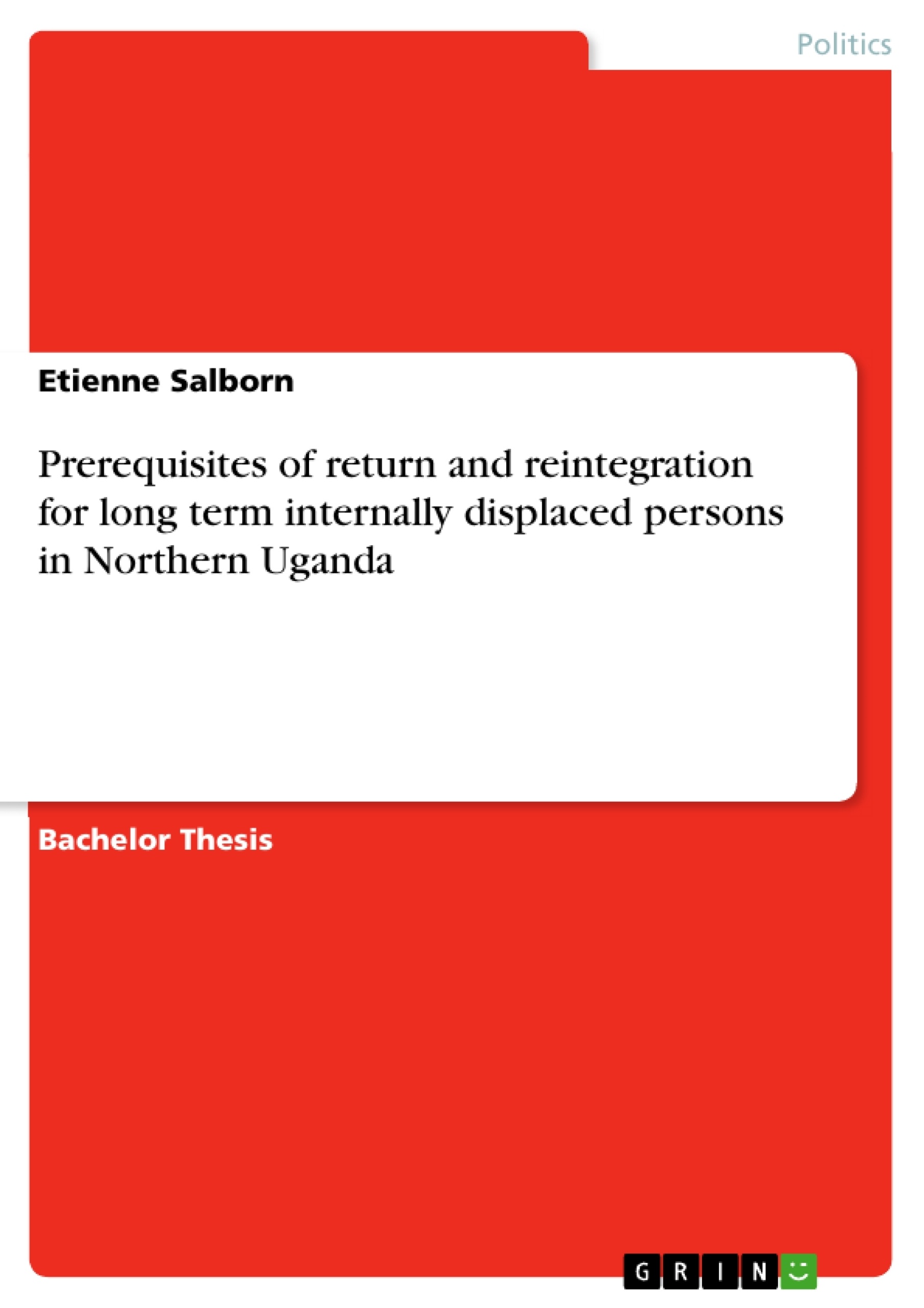Relative peace since 2006, after 20 years of armed conflict in Northern Uganda, brings the possibility for the internal displaced persons (IDPs) to leave displacement camps and return to the area of their original residence. Through a standardized survey of 178 individuals from the Gulu district in Northern Uganda, this study
examines the needs and prerequisites of return and reintegration.
Lasting peace is the uttermost condition for any other prerequisite of this study. IDPs need the voluntary wish to return, which 75% did indicate since they are longing for their ancestral land to engage in agriculture and want to leave behind the harsh and
unfavourable conditions of the IDP camps. The population of the Gulu district has been highly traumatized by the lasting armed conflict, making counselling and psychological treatment of trauma necessary. 1/3 is suffering from nightmares and ¼ fears evil spirits from murdered members of their communities. Over 2/3 of IDPs
believe that justice was not achieved. Voluntary movement has to be guaranteed, as the returnees who felt forced to return show significantly high movement between the return area and the old IDP camp and lower ability for reintegration. Although,
90% of the once 1.8 million IDPs have returned, only 50% have been able to fully reintegrate back into a life of social, economic and cultural balance. The majority from the remaining IDPs are unable to return out of their own strength. 9% percent has lost hope to be able to return, since they cannot find assistance or do not have land to return to. 46% are extremely vulnerable, needing special
assistance and tailored interventions, as they lack the financial and human capacity to return. 1/5 of the IDPs do not know the boundaries of their land, and 1/3 are having ongoing land disputes. 42% claim to have no monetary income whatsoever and 16% are unable to supply themselves sufficiently with food. Infrastructure and
services need to be re-established, as the lack of shelter, schools, health centres and water sources are the main facilities the IDPs need in their return areas.
Inhaltsverzeichnis (Table of Contents)
- Initial situation and problem definition
- Goal and aim of study
- Research design and Instruments:
- Questionnaires
- The questionnaire for returnees
- The questionnaire for IDPs
- Choosing the district and the camps
- Unyama IDP camp
- Tetugu IDP camp
- Questionnaires
- Demonstration of results
- Data editing
- Demographics
- Gender and age
- Family structures and marital status
- Education
- Internally Displaced Persons
- The wish to return and possible alternatives
- Special case: Extremely Vulnerable Individuals
- Reasons for IDPs to remain in the camps
- Lack of housing and assistance
- The hope to receive assistance while staying in camp
- Knowing the boundaries of land as a prerequisite for return
- Credit facilities - a possibility for the return progress?
- Direct needs of IDPs
- What would IDPs spend money on?
- Income activities now and after return
- Reintegration of Returnees
- Trauma and justice
- Spirits
- Integration and comfort
- Challenges for successful reintegration
- Crime
- Modern life learnt in camp
- Mobile phones and television
- Issue of land disputes
- Being forced to return and the consequences
- Moving between camp and return site
- Landmines
- Trauma hindering integration
- Governmental approaches
- Distribution of resettlement kits
- Comparison of IDPs and returnees
- Nightmares
- Income
- Crime
- Care of Extremely Vulnerable Individuals
- Discussion
- Limitations
- Supervision for data collection
- Gender differences
- Potential selection bias
- Sensitivity of the study
- Loss in translation
Zielsetzung und Themenschwerpunkte (Objectives and Key Themes)
This bachelor thesis examines the prerequisites for return and reintegration of long-term internally displaced persons (IDPs) in Northern Uganda. The study aims to understand the challenges and needs faced by IDPs and returnees in their respective contexts, shedding light on factors hindering successful reintegration.
- Challenges and needs of IDPs and returnees
- Factors influencing the return and reintegration process
- The role of government and other stakeholders in facilitating reintegration
- The impact of trauma and conflict on the return and reintegration process
- The importance of land rights and access to resources for successful reintegration
Zusammenfassung der Kapitel (Chapter Summaries)
The initial chapters lay the foundation for the study, outlining the problem definition, research design, and methodology employed. The study focuses on the experiences of IDPs residing in Unyama and Tetugu camps, exploring their reasons for remaining displaced and their perspectives on return.
Chapter 4 presents a detailed demographic analysis of the study participants, highlighting key characteristics and factors that shape their experiences. The study then delves deeper into the individual perspectives of IDPs, investigating their motivations for staying in the camps, their understanding of land rights, and their access to credit facilities. Chapter 5 examines the challenges faced by returnees in reintegrating into their communities, focusing on issues related to trauma, justice, and integration.
The remaining chapters explore the broader challenges hindering successful reintegration, including the impact of modern life learned in the camps, land disputes, and the role of governmental initiatives in supporting returnees. The study culminates in a comparison of the experiences of IDPs and returnees, highlighting key differences in their perceptions and needs.
Schlüsselwörter (Keywords)
This study explores key issues related to return, reintegration, internally displaced persons, Northern Uganda, trauma, justice, land rights, credit facilities, and governmental initiatives. It examines the experiences of both IDPs and returnees, providing insights into their unique challenges and needs in the context of post-conflict recovery.
- Quote paper
- Etienne Salborn (Author), 2010, Prerequisites of return and reintegration for long term internally displaced persons in Northern Uganda, Munich, GRIN Verlag, https://www.grin.com/document/163411



